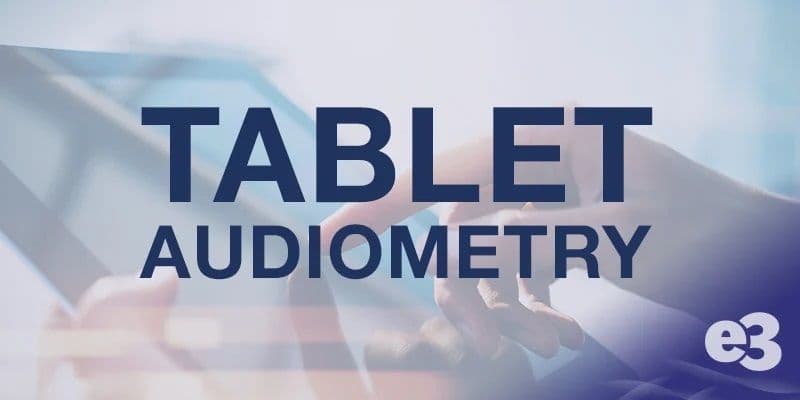Traditional vs Tablet Audiometers in OccuHealth Tests

A few decades back, audiometer manufacturers started embracing microprocessor technology. Since then, smart phones, tablets, and wireless internet have emerged, ultimately leading to the advent of tablet audiometers. Manufacturers of these devices claim that they are clinically validated, ANSI and ISO compliant, NOAH certified, and HIPAA compliant. These devices, without a doubt, are easy to use, affordable, and innovative. However, can they compare to conventional hearing testing systems using microprocessor audiometers, electro-acoustic simulators, and noise-attenuating sound booths?
Tablet vs. Traditional
Recent innovations have allowed hearing care professionals to download audiometer apps on their tablets to conduct hearing tests. In comparison to traditional audiometers, tablets are inexpensive. Their simplicity of initial setup, low cost, and availability suggest they offer an attractive and viable alternative to traditional audiometers and sound rooms.
Traditional audiometers meet the criteria of a medical diagnostic device. They are stable, can be reset to factory specifications, can be enhanced with firmware updates, and can integrate with many occupational health management software programs. The audiometer, handswitch, and headset are checked daily - most often by using an electro-acoustic simulator. OSHA annual calibrations are performed using more sophisticated calibration instruments.
While traditional audiometers have a life cycle of approximately 8-15 years, the life cycle for a tablet is much shorter. New tablet models release every year, and each lasts 2 or 3 years. When tablet models change, their hardware, firmware, memory and operating systems change. These changes may affect the performance of applications that were designed to operate with a specific model or operating system. Hardware changes and updates can disable important audio functions or affect linearity and volume levels.
When tablet manufacturers modify their operating systems, new modifications can affect performance and app stability. Software designed to run on a particular operating system may not function similarly on another. So, essentially, there’s no guarantee that an older app will run properly on a newer operating system. There is also no guarantee that support for older tablets or apps will be available in 10 or 15 years.
Calibration
Daily calibration checks are often made with an electro-acoustic ear since response levels are more stable, reliable, and quick in comparison to a human. Audiometers interface with electro-acoustic ears via the audiometer response button jack. However, some tablet audiometers do not have response buttons and, therefore, a human subject must be used to conduct the daily bio-acoustic check.
Annual calibration procedures validate the integrity of the entire audiometric testing system - the audiometer, sound booth cables/jacks, headphone cables, headband, and earphone cushions. A failure of any of these components will compromise results. OSHA audiometer calibration procedures are very specific. The audiometer AND its associated headset must be acoustically calibrated annually.
Validation & Specificity
For hearing professionals, formal audiometric testing is the gold standard for diagnosing hearing loss and monitoring treatment. In occupational hearing conservation programs, it is the identification of patient baseline hearing thresholds and the monitoring of changes in thresholds that are inherent in evaluating standard threshold shifts and identifying occupational hearing loss. Any procedure for validation in hearing conservation involves the use of a calibrated audiometer, a competent technician or hearing professional, and an OSHA-compliant hearing testing environment.
Validation studies have investigated how well tablet audiometers can identify hearing loss; i.e. does the patient have a mild or moderate hearing impairment. While hearing loss is always a concern, the more important issue is whether an employee’s hearing has changed. Hearing loss is not the same as a change in hearing thresholds. Therefore, tablet-based audiometers need to validate their studies based on STS and not on hearing loss classification.
One study by the Mayo Clinic found that 4.8% of results from the tablet device differed by 10 dB or greater than those determined by conventional audiometry, and that crosstalk and linearity failed in initial assessments. Another study had sensitivity as low as 86.5 suggesting that almost 14% of patients were not diagnosed correctly. Excessive crosstalk and non-linearity problems means that these tablets were not ANSI and OSHA compliant at the time of initial testing.
Regarding the use of sound booths for testing, audiologists look at several factors that can influence hearing thresholds. The frequency of background noise and upward spread of masking play a significant role with low frequency sounds. Auditory vigilance is an issue when competing speech, music or environmental sounds influence concentration. Noise does not need to be loud to affect results.
Conclusion
While tablet audiometers can be a cost-effective tool for hearing conservationists, there are no studies that examine their specificity and sensitivity when evaluating standard threshold shifts. The methodology for OSHA calibration compliance may be flawed and quality control issues were found in referenced validation studies.
More studies need to be conducted that evaluate the effectiveness of STS determination when noise cancelling devices alone are used in intermittent low frequency industrial noise environments. Simply put, there is insufficient evidence to suggest that tablet audiometers and noise reduction technologies are currently suitable for use in occupational hearing conservation programs.
